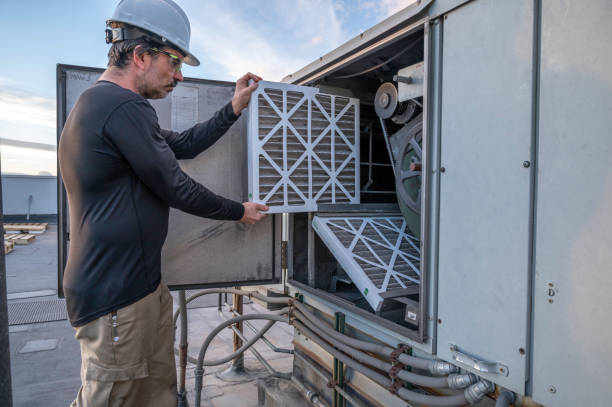Yes, Swamp coolers offer a refreshing alternative to traditional air conditioning systems but how does swamp coolers work? These ingenious devices harness the natural process of evaporation to cool the air, making them both eco-friendly and cost-effective.
In this piece, we’ll cover everything you’ll need to know about swamp coolers and how Swamp coolers work.
Table of contents
What Is A Swamp Cooler?

A swamp cooler, also known as an evaporative cooler, is a cooling device that utilizes the natural process of water evaporation to lower the temperature of air. It consists of a fan, water-soaked pads, and a pump. The fan draws warm air through the wet pads, causing the water to evaporate and cool the air in the process. This cooler, cost-effective method is widely used in arid regions and offers an energy-efficient alternative to traditional air conditioning systems.
Can A Swamp Cooler Be Used In All Climates?
Swamp coolers are most effective in hot and dry climates where the air is low in humidity. They work by adding moisture to the air through evaporation, creating a cooling effect. In more humid climates, where the air already holds a significant amount of moisture, the efficiency of swamp coolers decreases. So, while they are well-suited for arid regions, their effectiveness diminishes in areas with high humidity.
Is A Swamp Cooler Cost Effective?
Swamp coolers are generally considered cost-effective, both in terms of initial installation costs and ongoing energy consumption. They are typically more affordable to purchase and install compared to traditional air conditioning systems. Additionally, they use less electricity, as they rely on the natural process of evaporation rather than energy-intensive refrigeration.
Are There Any Benefits To Using Swamp Coolers Over Traditional Air Conditioning System?
Yes, there are several benefits to using swamp coolers over traditional air conditioning systems:
- Energy Efficiency: Swamp coolers consume less electricity than conventional air conditioners, making them more energy-efficient, especially in hot and dry climates.
- Cost-Effective: The initial cost of purchasing and installing a swamp cooler is generally lower than that of a traditional air conditioning system. Additionally, operating costs are often lower.
- Environmentally Friendly: Swamp coolers use the natural process of water evaporation, which is a more environmentally friendly cooling method compared to the refrigerants used in traditional air conditioners.
- Fresh Air Circulation: Swamp coolers continually bring in fresh outdoor air, providing better ventilation and avoiding the recirculation of indoor air, which can improve indoor air quality.
- Simple Maintenance: Swamp coolers have fewer complex components, making them easier and less expensive to maintain. Regular cleaning and pad replacement are usually the primary maintenance requirements.
How Does Swamp Coolers Work?
Swamp coolers, or evaporative coolers, work by harnessing the cooling effect of water evaporation. Here’s a basic overview of their functioning:
- Water Soaked Pads: A swamp cooler contains water-soaked pads typically made of cellulose or other absorbent materials. These pads are located in the cooling unit of the device.
- Fan: The cooler is equipped with a fan that draws warm, dry air from the outside through the water-soaked pads.
- Evaporation Process: As the warm air passes through the wet pads, water evaporates into the air. This evaporation process absorbs heat from the air, resulting in a temperature drop.
- Cool, Moist Air Output: The now-cooled and moistened air is then blown into the living or working space, providing a refreshing and cooler environment.
- Continuous Process: The process is continuous, as long as the pads remain wet. A water pump is often used to circulate water from a reservoir onto the pads, ensuring a constant supply for evaporation.
Frequently Asked Questions
Swamp coolers are most effective in hot and dry climates.
Swamp coolers are generally more energy-efficient than traditional air conditioners. They use the natural process of water evaporation, consuming less electricity compared to the refrigeration systems in conventional air conditioners.
Yes, swamp coolers can be used indoors, but they are most effective in spaces with good ventilation.
Regular maintenance involves cleaning the water pads, checking and adjusting water levels, and ensuring proper ventilation.
Yes, swamp coolers are generally more cost-effective in terms of both initial installation and ongoing operational costs. They are often more affordable to purchase, and their energy consumption is lower, especially in dry climates.
Yes, swamp coolers are suitable for residential use, particularly in regions with low humidity.
Yes, swamp coolers add moisture to the air during the cooling process. While this can be beneficial in dry climates, it’s important to monitor indoor humidity levels to prevent excessive moisture, especially in more humid environments
Conclusions
Swamp coolers, with their ingenious use of evaporation, offer a breath of fresh air. Their energy efficiency, cost-effectiveness, and environmentally friendly nature make them a compelling choice, particularly in hot and dry climates.
References
- landmarkhw.com – How Does A Swamp Cooler Work
- energy.gov – Evaporative Coolers
- howstuffworks.com – How Swamp Coolers Work
Recommendations
- How Big is 10 Acres of Land? (Visual Examples for Comparison)
- How Many Months is 60 Days? (Explaining the Calculation Process)
- How Big is 5 Inches? 6 Items with Accurate Measurement
- How Long Are Menards Rebates Good For?
- How Tall Is All Might? Everything To Know About Hero Academia
- How Tall is Kevin Gates? Everything about the Rapper
- How Long Are HS Football Games? (Explained)
- How Tall is Trippie Redd? Everything About the Rapper





